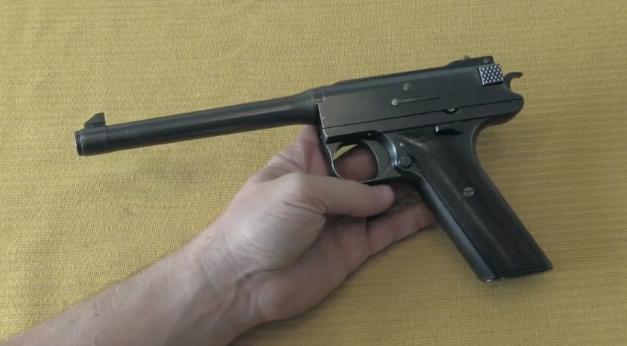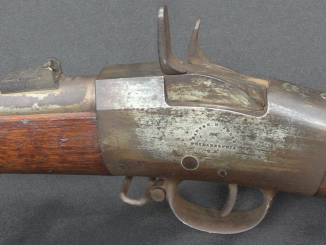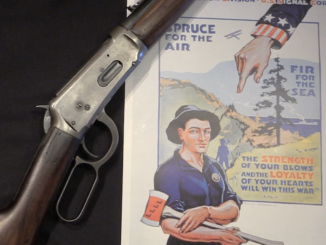This carbine is lot #3208 in the upcoming Rock Island May 2019 auction.
George Morse was one of the most significant American inventors in the development of modern ammunition. In 1856 he received a patent for the first completely self-contained brass cartridge, and a breechloading firearm to use it. Morse’s cartridge was made of several parts, a solid brass case head with a case body made of a piece of flat brass rolled into a cylinder and soldered down its seam, and then soldered to the case head. At the base, a standard percussion cap was seated and sealed in place with a rubber washer.
Morse entered his rifle in a US military trial in 1857, where is did very well but ultimately lost out to the Burnside carbine. In order to generate some cash flow while pursuing a contact to convert military muzzleloaders to his breechloading system, Morse contracted with the unmaking company of Muzzy & Co to make 100 of his guns for commercial sale. These were marketed as cased sets with one receiver and a carbine barrel, a rifle barrel, and a shotgun barrel (calibers varied, .48-.54 for the rifled barrels and 12 or 16 gauge for the shotgun barrel). The price for these sets was $125, quite a lot of money in 1857. The guns did not sell well, much to Morse’s dismay.
However, he was able to get a contract with the US military for a $5 royalty on each of 2000 guns they would convert to Morse’s system. This work had stalled by 1860, when it was moved to the Harper’s Ferry arsenal. No long after that, the Civil War would erupt, and needless to say the conversion project ended with the sacking of the arsenal. Morse would side with the Confederacy, and pursue production of his rifles in the South, which is the subject for a separate video…




“unmaking company”
What does that mean in U.S. parlance?
“price for these sets was $125, quite a lot of money in 1857”
Using gold prices: http://onlygold.com/Info/Historical-Gold-Prices.asp the 1857$125 is equivalent to 2015$6398.
However it might be easier to imagine how pricey it was using this table:
https://outrunchange.com/2012/06/14/typical-wages-in-1860-through-1890/
in 1860 out of shown skilled tradesmen best payed was carpenter at 10.92 weekly* which mean he would need 12 weeks to accumulate 125, assuming no outgoings at all.
* DISCLAIMER: with 60 h of work pay day, that is more than 20th century standard of 40 h.
is: “(…)pay day,(…)”
should be: “(…)per week,(…)”
“unmaking” should be “Gun making,” it’s another case of auto-incorrect kicking Ian!
Thanks for explanation, at first glance I was thinking that is company doing old building demolition (unmaking), but it did not fit there.
Anyway, I would overlook important issue: ammunition price and availability – even if you would buy that advanced (and expensive) fire-arm, without ammunition it would be at most bludgeon (with very poor cost-effect ratio).
So what was price of ammunition for that weapon?
Whatever the price, it was probably far too rich for ordinary folks.
As I look at the listing I am really regretting not buying one that hung around my LGS for ~$1000.
My favorite George Morse firearm invention was his ultra-über-simple musket designed in South Carolina during the War of the Rebellion, erm, uh, the, eh, “late unpleasantness”:
http://ww2.rediscov.com/spring/VFPCGI.exe?IDCFile=/spring/DETAILS.IDC,SPECIFIC=9783,DATABASE=objects,
What a wonderful percussion lock mechanism! I’d love to be able to make one of these. Maybe someday!
This design could have been the “last ditch” musket of the doomed Confederacy. I suppose we should be grateful that the worst war in North America was not lengthened appreciably any longer than it already was… A very interesting firearm designer, as Ian noted, and the nephew of the inventor of “Morse Code!”
The great-grandfather of SMS messaging
I wish our modern weapons-procurement failures took this route; just think of all the cool abandoned LMGs and PDWs and G11s we’d have by now!
Nitinol could be used in G11’s, interesting material; albeit not new, but uses in firearms could be. New…